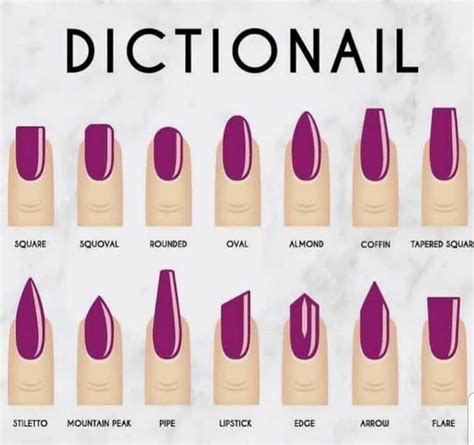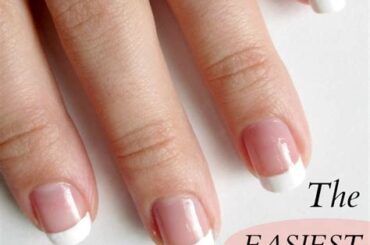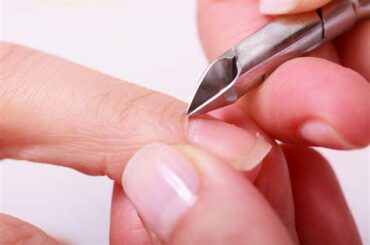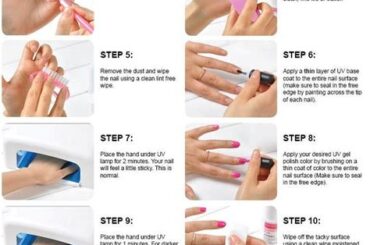Different nail types and characteristics
When it comes to nail care and manicures, it’s important to understand that not all nails are created equal. Just as our hair and skin have unique characteristics, our nails also have their own distinct qualities. By identifying and understanding the different nail types and their characteristics, you can better care for and enhance the beauty of your nails.
One of the most common nail types is the normal nail. These nails have a smooth texture, are neither too hard nor too soft, and have a well-rounded oval shape. Normal nails are generally easy to maintain and are less prone to breakage. They are considered the ideal type of nails.
Another type of nail is the brittle nail. Brittle nails are characterized by their thin and fragile nature. They tend to split and break easily, making it challenging to grow them long. Brittle nails can be caused by a variety of factors, such as excessive use of harsh nail products, frequent exposure to water, and nutritional deficiencies. Proper nail care, including regular moisturizing and avoiding harsh chemicals, can help improve the strength and appearance of brittle nails.
On the opposite end of the spectrum, we have the hard and thick nails. These nails are often difficult to trim and can appear yellowish. Hard and thick nails are commonly caused by genetics, fungal infections, or conditions such as psoriasis. To manage these types of nails, it’s essential to soften them with warm water or nail soaks before trimming. Regular moisturizing and gentle filing can also help improve their texture and appearance.
- Normal nails: Smooth texture, well-rounded oval shape
- Brittle nails: Thin, fragile, prone to splitting and breaking
- Hard and thick nails: Difficult to trim, yellowish appearance
| Nail Type | Characteristics |
|---|---|
| Normal nails | Smooth texture, well-rounded oval shape |
| Brittle nails | Thin, fragile, prone to splitting and breaking |
| Hard and thick nails | Difficult to trim, yellowish appearance |
Lastly, we have the ridged or corrugated nails. These nails have visible ridges or lines running from the cuticle to the tip. Ridged nails can be a result of various factors, including aging, nutritional deficiencies, and certain medical conditions. Regularly moisturizing the nails and using ridge-filling base coats can help minimize the appearance of ridges and make the nails appear smoother.
Understanding the characteristics of your nail type is essential in order to provide the appropriate care and maintenance. Whether you have normal, brittle, hard and thick, or ridged nails, there are specific techniques and products available to enhance the beauty and health of your nails. By tailoring your nail care routine to suit your nail type, you can achieve beautiful and strong nails that you’ll be proud to show off.
Identifying your nail type: shape and texture
When it comes to identifying your nail type, understanding its shape and texture is key. Different nail types have different characteristics that require specific care and maintenance. By correctly identifying your nail shape and texture, you can enhance the beauty of your nails and ensure they stay healthy and strong. Let’s dive into the world of nail types and how you can identify yours.
Nail Shape:
The shape of your nails plays a crucial role in determining your nail type. There are several common nail shapes, including square, rounded, oval, almond, and stiletto. Square-shaped nails have straight, sharp edges and a flat top, while rounded nails have a curved edge and no sharp angles. Oval nails are similar to rounded nails but have a slightly elongated shape, resembling an oval. Almond-shaped nails are tapered at the sides and pointed at the tip, resembling the shape of an almond. Stiletto nails are long and pointed, giving a fierce and dramatic look.
Nail Texture:
Along with nail shape, the texture of your nails also varies from type to type. The texture refers to how smooth or rough the surface of your nails is. Some common nail textures include smooth, ridged, and peeling. Smooth nails have a glossy and even surface, indicating good health. Ridges, on the other hand, are vertical lines or bumps that can occur due to aging or certain health conditions. Peeling nails have layers that separate from one another, making them prone to breaking and splitting.
- Identifying Square Nails: Square nails have straight, sharp edges and a flat top. They are strong and bold in appearance, making a statement.
- Identifying Rounded Nails: Rounded nails have a curved edge and no sharp angles. They are ideal for those who prefer a softer, more feminine look.
- Identifying Oval Nails: Oval nails are similar to rounded nails but have a slightly elongated shape, resembling an oval. They are versatile and suit various nail art designs.
| Nail Shape | Characteristics |
|---|---|
| Square | Straight, sharp edges; flat top |
| Rounded | Curved edge; no sharp angles |
| Oval | Slightly elongated shape; resembles an oval |
By recognizing the shape and texture of your nails, you can customize your nail care routine accordingly. Whether you have square nails that require regular filing or rounded nails that need extra protection, understanding your nail type will help you maintain their health and beauty. So, take a closer look at your nails and discover the unique characteristics that define your nail type!
Understanding the needs of your nail type
Nails are not just for decoration; they can also tell a lot about our overall health. Understanding the needs of your nail type is crucial for maintaining healthy and beautiful nails. There are several different nail types, each with its own characteristics and care requirements. By identifying your nail type and understanding its specific needs, you can ensure that your nails stay strong and vibrant.
One common nail type is the brittle nails. Brittle nails are prone to breakage and splitting. They often lack moisture and are easily damaged by external factors such as harsh chemicals and excessive filing. To care for brittle nails, it is important to keep them moisturized by regularly applying a nourishing nail oil or lotion. Avoid using harsh nail products and opt for gentler formulas. Additionally, wearing gloves while doing housework or other activities that may expose your nails to chemicals can help protect them.
Another nail type is the weak nails. Weak nails are often soft and easily bendable. They are more prone to peeling, breaking, and chipping. To strengthen weak nails, consider incorporating a strengthening nail treatment into your routine. These treatments usually contain ingredients like biotin, keratin, and vitamins that help promote nail strength and growth. Avoid excessive filing or buffing, as this can weaken the nails further. Additionally, protecting weak nails with a base coat before applying nail polish can provide an extra layer of reinforcement.
The last nail type we will discuss is the ridged nails. Ridged nails have vertical lines or grooves along the nail plate. These ridges can make the nails appear dull and can also cause them to become weak and prone to splitting. To improve the appearance and health of ridged nails, it is recommended to regularly buff the nails in one direction to smooth out the ridges. Using a ridge-filling base coat can also help create a smoother surface for nail polish application. Additionally, keeping the nails hydrated and moisturized can help minimize the appearance of ridges.
List of Nail Types and Their Characteristics:
| Nail Type | Characteristics |
|---|---|
| Brittle Nails | Prone to breakage and splitting, lack moisture |
| Weak Nails | Soft, easily bendable, prone to peeling and chipping |
| Ridged Nails | Vertical lines or grooves, weak, prone to splitting |
Understanding the needs of your nail type is key to maintaining the health and beauty of your nails. By providing the necessary care and attention, you can ensure that your nails remain strong, resilient, and attractive. Remember to consult with a professional if you are experiencing severe nail problems or if you have any concerns about your nail health.
Enhancing the beauty of short nails
Short nails can be just as beautiful and stylish as long nails, if not more so. They offer a clean and polished look that is perfect for both professional and casual settings. Many people with short nails often feel limited in terms of nail art and design options, but that couldn’t be further from the truth. In fact, short nails can be enhanced and adorned in various ways to showcase your individual style and personality.
One way to enhance the beauty of short nails is by opting for a neat and well-maintained look. Keep your nails trimmed and filed to a length that suits your preference. Short nails are less prone to breakage and chips, making them easier to maintain. Regularly moisturizing your nails and cuticles will keep them healthy and prevent any dryness or brittleness.
To add a touch of glamour to your short nails, consider different types of nail polish or nail art. Experiment with bold colors, unique patterns, and intricate designs. You can also try out nail stickers, decals, or even opt for a minimalist negative space manicure. The key is to find a style that complements your taste and the occasion.
List of enhancing techniques for short nails:
- Regular nail care and moisturization
- Trimming and filing to desired length
- Exploring different nail polish colors and finishes
- Getting creative with nail art or using nail stickers
- Trying out negative space manicures for a minimalist look
Now, let’s dive into some more details to better understand each of these techniques for enhancing the beauty of short nails.
| Technique | Description |
|---|---|
| Regular nail care and moisturization | Keep your nails moisturized and maintain a regular nail care routine to prevent dryness and brittleness. |
| Trimming and filing to desired length | Keep your nails at a length that feels comfortable and suits your personal style. Regularly trim and file them to avoid any uneven edges. |
| Exploring different nail polish colors and finishes | Experiment with various nail polish shades, from vibrant and bold to subtle and pastel. Try different finishes like glossy, matte, or metallic. |
| Getting creative with nail art or using nail stickers | Express your creativity with nail art designs that are specifically tailored for short nails. Use nail stickers or decals for easy and quick adornment. |
| Trying out negative space manicures for a minimalist look | Create a trendy and modern look by leaving portions of your nails bare, exposing the natural nail color amidst carefully placed nail art or designs. |
Overall, enhancing the beauty of short nails is about embracing their unique characteristics and working with what you have. With the right care, creativity, and a dose of confidence, you’ll be able to showcase your short nails in a way that reflects your personal style and enhances your overall look.
Tips for nail care and maintenance based on nail type
Nail care and maintenance is essential for keeping your nails healthy and beautiful. However, not all nails are created equal, and different nail types require different care routines. By understanding your nail type and its specific needs, you can ensure that your nails stay strong, clean, and looking their best.
Identifying Your Nail Type: Shape and Texture
Before diving into nail care tips, it’s important to identify your nail type based on its shape and texture. There are several common nail types, including:
| Nail Type | Description |
|---|---|
| Square | Nails have straight sides and sharp corners. |
| Oval | Nails are rounded at the tip and slightly wider at the base. |
| Almond | Nails are tapered and pointed at the tip. |
| Squoval | Nails combine the features of square and oval shapes. |
Understanding the Needs of Your Nail Type
Once you’ve identified your nail type, you can better understand its specific needs. For example, square-shaped nails are prone to breakage at the corners, so keeping them short is recommended. On the other hand, almond-shaped nails require regular filing to maintain their pointed tips and prevent them from becoming too long.
Additionally, your nail’s texture plays a role in its care routine. If you have brittle nails, it’s important to avoid harsh chemicals and excessive filing. Gel or acrylic nails may require special care and maintenance to prevent lifting or chipping.
Tips for Nail Care and Maintenance Based on Nail Type
Now that you know your nail type and its specific needs, here are some general tips for nail care and maintenance:
- Keep your nails clean by regularly washing them with a gentle soap.
- Moisturize your nails and cuticles daily with a nourishing oil or cream.
- File your nails regularly to maintain your desired shape and prevent rough edges.
- Avoid using your nails as tools to prevent breakage or damage.
- Apply a strengthening base coat before applying nail polish to protect your nails.
- Regularly trim your nails to prevent them from becoming too long or prone to snagging.
- Avoid biting your nails or picking at your cuticles to prevent infections.
By following these tips and understanding your nail type, you can keep your nails healthy, strong, and beautiful. Remember, every nail is unique, so experiment with different products and techniques to find what works best for you. Happy nail care and maintenance!
Frequently Asked Questions
Q: How can I identify my nail type based on its shape and texture?
A: There are several common nail types based on their shape and texture, such as square, oval, round, almond, and pointed nails. Square nails have straight, flat tips, while oval nails have rounded tips. Round nails have curved edges, almond nails are narrow with rounded tips, and pointed nails have long, tapered tips. The texture of nails can vary from smooth and shiny to ridged or brittle.
Q: What are the characteristics and needs of square nails?
A: Square nails are known for their strong and sturdy shape. They have a flat surface that provides a wide canvas for nail art. Square nails require regular filing to maintain their shape and prevent sharp edges. They may be more prone to breakage compared to other nail shapes.
Q: How do I enhance the beauty of short nails?
A: There are several ways to enhance the beauty of short nails. You can opt for a natural, buffed look or apply a clear or light-colored polish to create the illusion of longer nails. French manicures and nail art designs can also make short nails look stylish and eye-catching.
Q: What are some tips for nail care and maintenance for different nail types?
A: For square nails, regular filing is important to maintain their shape. Oval and round nails should be filed to follow the natural curve of the fingertip. Almond nails require gentle filing to maintain their pointed shape. It is important to keep all nail types hydrated with moisturizers and cuticle oils, and to avoid harsh chemicals and excessive exposure to water to prevent brittleness and breakage.
Q: How can I identify the texture of my nails and address specific concerns?
A: To identify the texture of your nails, examine their surface for smoothness or ridges. Smooth and shiny nails are generally healthy, while ridged nails may indicate underlying health issues. If you have ridged nails, it is advisable to consult a healthcare professional to address any potential concerns.
Q: Is it necessary to follow a specific nail care routine based on my nail type?
A: While there is no one-size-fits-all nail care routine, understanding your nail type can help you tailor your routine accordingly. Different nail types may have specific needs, such as regular filing for square nails or gentle shaping for almond nails. However, basic care practices such as keeping nails moisturized and protected and avoiding excessive exposure to harsh chemicals apply to all nail types.
Q: How can I maintain healthy nails and promote their growth?
A: To maintain healthy nails and promote their growth, it is important to practice good nail care habits. This includes maintaining a balanced diet rich in essential nutrients, keeping nails properly moisturized, protecting them with gloves during household chores, and avoiding excessive use of nail products or harsh chemicals. Regular manicures and gentle filing can also support nail health.





